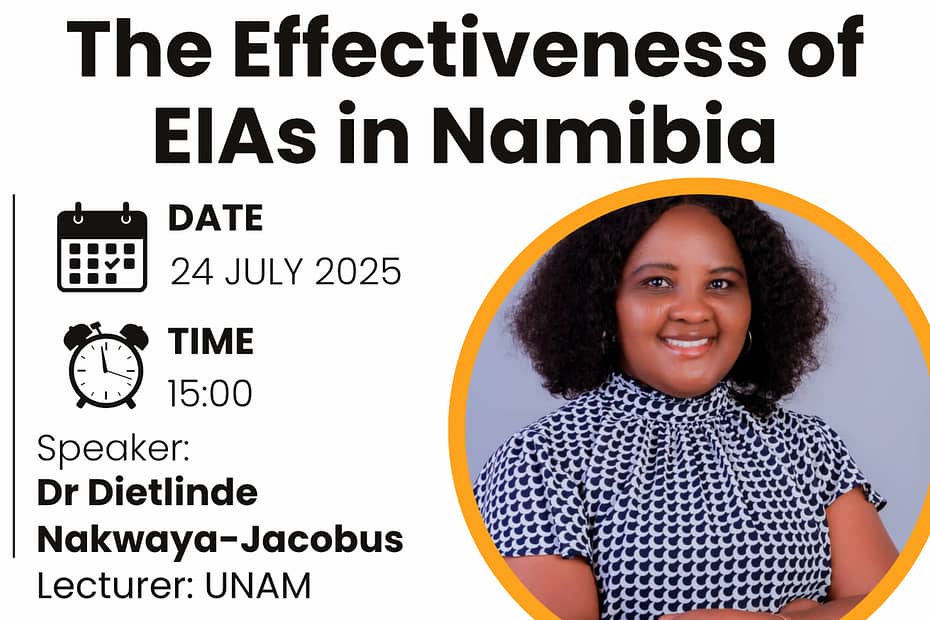Imagine a world where everyone developed whatever they want and wherever they wished. Disastrous is an understatement – our planet and society would crumble. Environmental impact assessments (EIAs) are processes that evaluate the potential environmental effects of a proposed project or development. Human activities, big or small, have an impact on the environment. The impacts of each development add to those that have gone before it and will come afterwards, so these factors should also be taken into account.
How does Namibia ensure that development isn’t harmful to our environment and society? Who is regulating these processes? What can we do differently?
On 24 July 2025, the Namibian Youth Chamber of Environment, in collaboration with the University of Namibia (UNAM), hosted a webinar on the effectiveness of EIAs in Namibia. Dr Dietlinde Nakwaya-Jacobus, a senior lecturer at UNAM’s Sam Nujoma Campus in Henties Bay, shared her recent PhD research findings focused on evaluating the performance, quality and effectiveness of EIA policies in Namibia.
She combined quantitative and qualitative tools to evaluate the current systems’ performance, analyse the quality of EIA processes, understand the perspectives of key actors, and learn from case-based practical challenges. The research involved administering surveys to 110 respondents and conducting in-depth interviews with EIA experts and practitioners. The study was further supplemented with two relevant case studies: the Namibia Marine Phosphate (NMP) project off the coast near Luderitz and the ReconAfrica oil drilling project in Kavango Region.

Key findings of the research
The findings revealed that Namibia’s EIA system is in place but only partially meets international criteria. While it satisfies general requirements, it lacks foundational measures such as the implementation of Strategic Environmental Assessments (SEA), which are essential for long-term environmental planning and assessing cumulative impacts of developments. Even though Namibia has environmental laws, enforcement is weak, and high-profile developments often proceed without adequate environmental compliance. Examples include the extension of the Platz A-meer raft and the construction of a container terminal at the coast, both of which reportedly ignored environmental recommendations. The stakeholders that Dr Nakwaya-Jacobus interviewed highlighted the lack of communication between government institutions and local authorities, which further undermines the purpose and execution of EIAs.
In terms of effectiveness in decision-making, the EIA process was considered moderately effective. Some developments have been paused due to EIA findings, including the marine phosphate mining project. However, many experts criticised the process for being too centralised, with the final decision resting with the Environmental Commissioner. There was a strong call for a more inclusive advisory committee to assist in national-level decision-making, thereby improving fairness and oversight.
The study also assessed the learning and leadership impacts of the EIA process. While the process has the potential to enhance public and institutional awareness, actual engagement remains low, particularly in rural communities. Most projects are handled by a small number of individuals within ministries, and there is limited knowledge transfer when staff leave their positions. From a transactional perspective, the EIA system was found to be financially underregulated and institutionally under-resourced. Experts pointed out that EIA consultants operate without clear pricing guidelines, often leading to inconsistencies and poor service delivery.
Dr Nakwaya-Jacobus further noted that the NMP and ReconAfrica projects provided practical illustrations of these EIA system weaknesses. The NMP project, while conducting an additional verification study, lacked proper environmental clearance and showed non-compliance with essential procedures. The ReconAfrica project failed to acknowledge important legislation concerning forestry and communal land, which are critical in assessing the project’s impact on biodiversity and local communities. In both cases, inadequate consultation methods and poor communication channels, especially for rural and marginalised communities, were major concerns.

Recommendations and conclusion
To improve EIA processes in Namibia, several adjustments must be made, according to Dr Nakwaya-Jacobus. Reforming EIA legislation and ensuring inclusive public engagement could be a starting point. Additionally, there was consensus that the Department of Environmental Affairs lacks the autonomy, funding and administrative power needed to fulfil its role effectively. Therefore, it should be established as an independent authority with adequate financial and human resources. Another suggestion would be to improve monitoringand documentation by strengthening legislation, reforming institutional frameworks and improving inclusivity mechanisms. These recommendations could enhance the EIA system’s impact.
In conclusion, the study found that EIAs have an important and preventive role in environmental governance by halting questionable projects. However, weaknesses in foundational tools, governance principles, stakeholder collaboration and public participation can undermine this role. The EIA process is meant to guide sustainable development in Namibia, but can only do so if it is adequately supported, reformed and widely understood, especially by young people who will eventually be the leaders in this sector.

